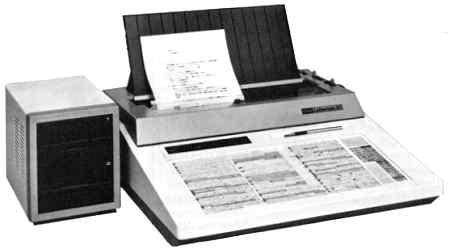
KEYBOARD
KARMA
by Alexander Randall V
Alexander Randall V manages the Boston Computer Exchange, conducting computer business worldwide.
The Japanese have keyboard problems that would cause the average American typist to dive for cover. At the core of their written language is an amalgam of three alphabets, each vastly more complex than the simple script of the western world.
Until the seventh century, Japan had a fully formed language with no written system at all. Then in 661 Japanese explorers, encountering the advanced culture of China, saw the remarkable utility of the Chinese pictographs and took them home to fit their own spoken language. These pictographs, called Kanji in Japanese, are line drawings that represent core concepts: a man, for example, is described by a stick figure with a trunk and legs; the pictograph for "big" shows a man with his arms outstretched; the horse symbol has four legs with hair streaming behind. There are more than 20,000 pictographic characters, though only about 2,300 are used in daily writing.
When it turned out that the Chinese pictures could not show all the nuances of spoken Japanese, a second phonetic writing system (Hiragana) was developed for more complex grammar. Later on, a third alphabet (Katakana) was created to cover the same sounds, but only for writing borrowed words from foreign cultures. In written Japanese, the phrase "I want a Coca-Cola" involves characters from each of the three alphabets: "I" and "want" come from the Chinese characters, but their grammatical markers are from Hiragana and "Coke" is written with the Katakana for foreign words.
While Americans can describe every conceivable thought with only twenty-six characters and a handful of symbols, the Japanese have to use two alphabets of forty-eight characters each and the massive Chinese pictograph system to write even the briefest of notes. Our compact set of characters led to the development of simple keyboards with all the letters and symbols, but how do you create a keyboard for thousands of characters?
In the early years of mechanical typing machines, the Japanese created a variety of keyboards to meet the challenge of their unusual language. Their early typewriters, more like typesetting machines than our typewriters, featured large flat trays of metal slugs each of which bore a separate character. The operator slid a pointer around the tray and aligned it with the desired character, then pushed a lever that grabbed the slug, picked it up and struck it against the paper. Since there was a limit on the size of these machines and the number of characters they could address, it was a major victory for written communication when the government announced that only a portion of the full character set was to be used in normal discourse.
These typesetting machines became the standard for most printed communication in Japan, and secretarial students spent a great deal of time learning how to type at eighty words per minute. Aside from improvements in the machines' efficiency and size, there were really very few changes in the technology until the introduction of electronic devices in the 1960s and '70s.
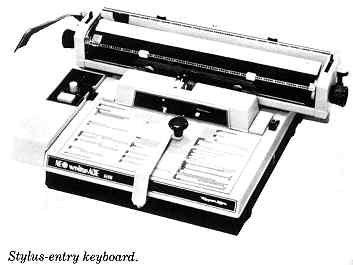
Without a simple keyboard tradition, the Japanese brought no prejudices to the computerized word processing era. A variety of machines and keyboards are in current use, and there are several different approaches to the character problem. One system uses a large digitizer pad that has the same layout as the old mechanical typesetter. The operator uses a pointer to indicate the desired character, and the digitizer sends the code for that character to the computer. The process is fast, but the pad requires a whole desk and extensive computer software to make it functional. The advantage is that the operator can input all the common characters. Since the digitizer has a lot of room, there is no reason not to include English, Greek and Russian characters as well.
Another approach involves a keyboard with each of a few hundred keys representing several different characters. One machine has a hundred well-spaced keys with plastic overlays that can change their designation. Each overlay has a set of holes along the edge that fit over light-sensitive points beside the keys and tell the machine which characters the keys are to represent. The operator flips frantically through the overlays to change from one set of characters to the next. The process can be slow, but there is virtually no limit to the number of characters the keyboard can address.
By far the most popular approach to keyboards in Japan is a modified version of the English-language key set (English characters are used for some programming tasks). Our twenty-six letters appear on the keys, as does one of the short phonetic alphabets; since each phonetic sound may represent several Chinese characters, the operator uses phonetic symbols to call a small set of these characters out of ROM memory onto the screen, picks out the one he wants and executes a command that enters it into the text. The process is slow, but at least the operator can work with a manageable keyboard.
For centuries, the Japanese have had to contend with a writing problem that cannot be solved by a borrowed answer. In developing their own solution, however, they could very well supply some answers to problems we all share. It should come as no surprise if Japan were to create a keyboard on a ball, for example, or do away with writing altogether in favor of speech recognition. Indeed, it is not unlikely that the first functional speech machines will come into our homes via Tokyo.
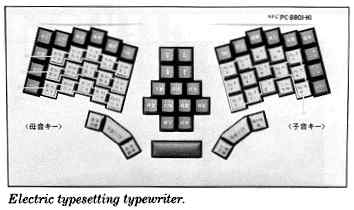
Keyboard cornucopia: To accommodate their sprawling alphabet/ideogram spelling system, the Japanese have designed a wide variety of word processing keyboards. The OKI Lettermate stylus-entry keyboard on page 267 uses a pointer and tablet for character entry. The Word Input Terminal (bottom right) uses large keys bearing as many as twelve different characters; selection is made with numbered control keys near the bottom right corner of the keyboard. The Oasys word processing system (below) uses the standard abbreviated Katakana alphabet set. The NEC keyboard (above) uses an unconventional key arrangement for greater comfort and speed.
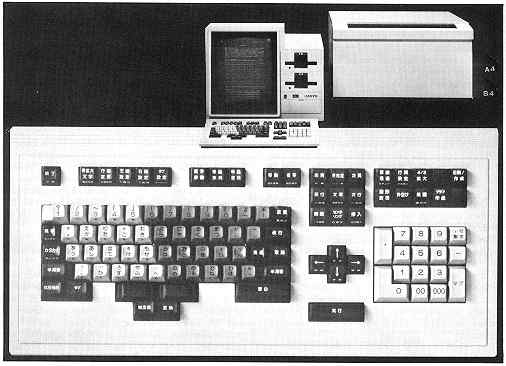
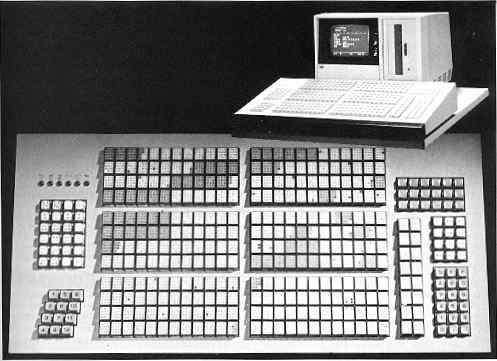
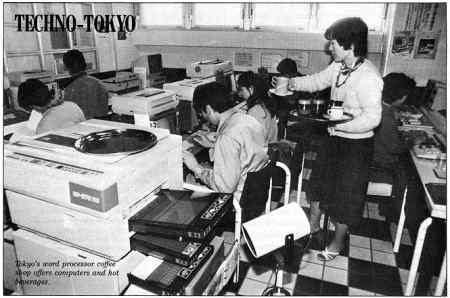 Tokyo's word processing coffee shop offers computers and hot beverages. Everyday life in modern Japan reflects an astonishing mix of ancient wisdom and scientific vision. Below are just a few of the ingenious uses assigned to the computer by the world's leading high-tech nation. • In the capital city of Tokyo, computerized traffic lights chime to let blind pedestrians know when the light turns green. Because the consultant who came up with this scheme was a Scotsman, the tune they hear is "Coming Through the Rye." Other developments on behalf of the blind include sidewalks and station platforms with Braille lines to allow easy, safe maneuverability. • Ever fashion-conscious, the Japanese have come up with the world's first software for hair salons. Customers have their photographs fed into a pasu-kon, or personal computer, so they can see how they look in the different hairstyles that are simulated on-screen. • Even the ancient practice of palmistry has been entrusted to the computer. Photocopies of palm prints are scanned by the machine, which reads the lines and sorts through its data base to tell the client's future. • The pitch of a baby's cry will automatically set his voice-activated crib rocking in a regular rhythm. If the crying persists, the crib-puter will sing a lullaby, tell a fairy tale or relay whatever comforting words have been programmed by the mother. When the baby becomes quiet, the crib stops its motion within thirty seconds. • Coffee shops, traditionally part of the casbah of Japan's Collective Unconscious, have added high tech to the menu. Today they feature word processors and printers in order to attract a more computer-literate crowd. • The Shinjuku Washington, the world's first truly high-tech hotel, has computer tellers that perform guest registration, accept advance payment for rooms, dispense change and issue a magnetic key card programmed to expire at the designated checkout time. After an animated character appears on the monitor and bows, welcoming the guest to the hotel and explaining how to check in by keyboard, the card is carried to the room and inserted in a special slot beside the door. A green light goes on, the door is opened and the card is inserted in a slot in the bedside console to activate the room's energy-saving electrical system: air conditioning, central heating, TV and lights. From then on, whenever the guest pulls an item from the mini-bar refrigerator (an "isotonic" drink, perhaps, or some dried cuttlefish), makes a phone call or watches a movie on the video system, the cost is tabulated by the hotel's central computer. • On the sidewalks of Tokyo, robots in colorful clown costumes perform tricks verging on slapstick to lure passers-by into stores and restaurants. Japan's lead in the "fifth generation" artificial intelligence race owes as much to its fascination with robots and children's cartoons as to advanced conceptual thinking. Indeed, AI technicians' labs are littered with colorful comics as they seek the breakthrough inspiration that may come at the turn of a page. ALEXANDER BESHER |
Return to Table of Contents | Previous Article | Next Article

